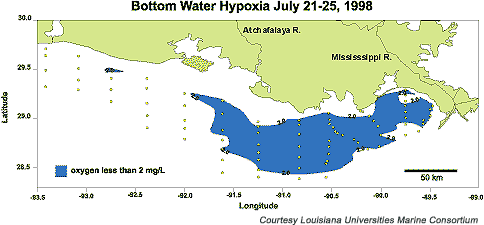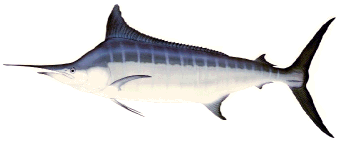As shown below, each year an area off Louisiana the size of New Jersey becomes a "Dead Zone" - depleted of oxygen.� Fish, shrimp and other fishery resources are eliminated.� The cause: excess nutrient loading.� Fertilizer and manure from farms throughout the Mississippi River drainage (covering 2/3 of the lower 48 states) needs to be cut sharply to repair this oxygen-deprived area.� In 1999, a White House study concluded the most cost-effective way to protect the Gulf would be to reduce fertilizer use by 20% and restore 5 million acres of wetlands to trap nutrients before they reach the Mississippi R. and its tributaries.� The Gulf's Dead Zone doubled in size to 7,000 sq. mi. after widespread Mid-west flooding in 1993, and has fluctuated annually since then depending on flows of the Mississippi.� The problem stems from algae that thrive on the excess nutrients.� As they die their decomposition robs the water's dissolved oxygen needed by fish and other marine life.�
Shellfish bed closures due to sewage loading exist coast-wide.� On any given day, one-third of the nation's 17.8 million acres of shellfish waters are closed, and in the Gulf of Mexico, 52% are restricted (USDC 1991) due, in part, to water quality degradation caused by inadequate septic systems, sewage discharges, and urban runoff.� Excessive additions of nutrients can stimulate nuisance and toxic growths of algae and deplete oxygen when these growths decay, frequently causing kills of fish and other resources.� Like the Dead Zone off Louisiana, nutrient over-enrichment is believed responsible for the loss of Chesapeake Bay's native seagrasses, a primary habitat for many juvenile fish and shellfish.� However, Federal grants for upgrading municipal sewage treatment systems have improved water quality in many areas, compared to pre-Clean Water Act conditions.� In 1991, beaches were closed or advisories issued against swimming on more than 2,000 occasions in states that monitor beach quality (only four states monitor the entire length of their shoreline).� Humans can contract a variety of diseases of bacterial and viral origin, such as gastroenteritis and hepatitis, if they become infected with pathogens associated with human sewage, through ingestion during water-based activities or through the consumption of contaminated raw or lightly cooked molluscan shellfish.� Shellfish growing waters may be affected by blooms of several species of diatoms and dinoflagellates that can cause a variety of human illnesses.� For example, some of Maine's productive shellfish growing waters have been closed for most years since 1958 because of the presence of dinoflagellate blooms responsible for paralytic shellfish poisoning.� The occurrence of these blooms is now affecting all productive shellfishing waters of the U.S. and at an increasing frequency, potentially stimulated by coast-wide nutrient over-enrichment.

Habitat
Habitat Protection Division
Inshore-Dependent Fish and Shellfish
Primary Causes of Fishery Population Declines
Dams and Flow Diversions
Wetland Destruction
Toxic Contaminants
Cumulative Effects
Economic Benefits of Effective Habitat Protection
References
Swordfish, Billfish, Tunas and Sharks
Headed for Extinction
Chambers and Associates
Overview
List of All Pages on this Website
Home

9814 Kensington Parkway
Kensington, Maryland 20895
(T) (301) 949-3003� (Fax) (301) 949-3003
Email�� [email protected]
Website�� www.Chambers-Associates.org